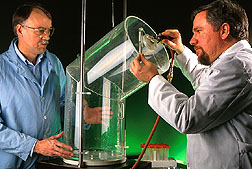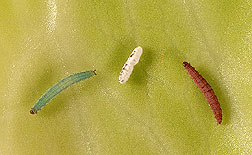Pitting Two Fungi Against Tough Pests
|
|
Could natural fungi help rein in important insect pests of vegetable and cereal crops?
Very possibly, according to ARS entomologist John D. Vandenberg. He has been focusing on whether two parasitic fungi in particular—Beauveria bassiana and Paecilomyces fumosoroseus—could become biological controls for diamondback moths and Russian wheat aphids.
"The Russian wheat aphid is a major pest of U.S. winter wheat and barley," says Vandenberg. "And the diamondback moth is a worldwide pest of cabbage, broccoli, canola, and other cruciferous crops."
Each year, farmers worldwide spend more than $1 billion to control diamondback moths—primarily with chemical insecticides," he notes. But in many areas, the moth has become resistant to conventional insecticides, as well as to natural bacterial controls such as Bacillus thuringiensis, or Bt.
In Vandenberg's tests so far, the moth succumbed to both fungi, while only the Beauveria had much impact on the aphid.
Alternatives to Bt
At least 10 other insects, including Indian meal moths, have developed some resistance to Bt, especially where farmers have used it extensively. But fungi are promising alternatives, according to Vandenberg, who is based at ARS' U.S. Plant, Soil, and Nutrition Laboratory in Ithaca, New York.
"With P. fumosoroseus," says Vandenberg, "field studies on application rates and residual effects on subsequent populations are needed to select appropriate strains. We also need to better understand and manage the fungal infection process."
In laboratory studies, Vandenberg and Cornell University graduate student Jennifer Altre compared eight strains of P. fumosoroseus for their ability to infect and kill the diamondback moth.
"We found dramatic differences among these strains in their relative virulence, spore size, germination speed, and ability of spores to attach to the surface of the insect," says Vandenberg.
"The highly virulent strains have larger spores that attach easily to the insect's cuticle and germinate quickly. A strain with smaller spores doesn't attach well, germinates slowly, and isn't able to infect the moth."
In laboratory experiments with B. bassiana, all larval stages of the moth were susceptible to infection. But larvae exposed to the spores shortly before molting avoided infection because they quickly shed their cuticle.
"Larvae died more quickly at moderate temperatures and when exposed to higher doses of B. bassiana spores," he says. "These studies will help us to predict the success of timely applications of field-applied fungi."
In related research, Vandenberg and Anthony M. Shelton, a Cornell University entomologist investigated B. bassiana for diamondback moth control on cabbage seedlings grown in screenhouses. Farmers who grow cabbage rely on these seedlings, which they transplant and grow in their fields.
"Commercial crucifer seedlings can be contaminated with insecticide-resistant diamondback moths," Vandenberg says. "By the time these seedlings become established in the field, diamondback moth larval populations can be high enough to require control."
A Commercial Product Works
Vandenberg and Shelton applied Mycotrol, a commercial formulation of B. bassiana, to infested cabbage seedlings. Mycotrol was developed through a cooperative research and development agreement between ARS and Mycotech Corporation of Butte, Montana. In March 1995, the U.S. Environmental Protection Agency approved its use on a variety of pests and crops.
Vandenberg and colleagues were the first to field-test Mycotrol's effectiveness on the diamondback moth. They found that weekly or twice-weekly applications significantly reduced insect populations and damage to seedlings, compared to water-sprayed controls.
"This treatment is as effective as conventional insecticides," Vandenberg says. "The fungus persists on treated leaves for more than 2 weeks to provide continued protection."
Both Mycotrol formulations—as wettable powder and as an emulsifiable suspension—reduced moth larval populations when applied to larger plants in the field. Multiple applications also improved performance. Field trials are under way using Mycotrol in com combination with conventional insecticides for season-long management of diamondback moths and other pests.
"These findings will allow industrial producers to select more useful strains of both fungi," he says. "It will help farmers more efficiently apply fungi for safe, effective biological control of the diamondback moth. These fungi should also work to control other moth pests."
Control of Russian Wheat Aphids
Vandenberg has also explored both fungi for control of the Russian wheat aphid, Diuraphis noxia. This aphid spends the winter primarily on wheat and barley throughout its North American range—16 states and 2 Canadian provinces. Since invading the United States in about 1986, the 1/16-inch-long green aphids have cost growers more than $850 million in insecticide treatments, crop yield losses, and other costs.
In field studies, Vandenberg and University of Idaho entomologist Larry E. Sandvol infested plots of spring-planted wheat with the Russian wheat aphid. They then tested spores of B. bassiana and P. fumosoroseusfor their ability to control the pest.
"We found significant reductions in aphid populations over all three seasons after spraying B. bassiana as Mycotrol," he says. Sampling 4 days after spraying revealed that 52 percent of the aphids on wheat tillers—shoots that sprout from the plant's base base—were infected with the fungus.
In 1997 and 1998, Vandenberg and Sandvol applied Mycotrol once to larger, 1-acre plots using a moveable pipe irrigation system. Aphid populations dropped significantly within 2 to 3 weeks after spraying.
He says these studies showed the potential for controlling the Russian wheat aphid using fungi. They proved that the treatment works on a large scale and has commercial potential.
Vandenberg says that although others have shown that other strains of B. bassiana work against this aphid, this is the first time Mycotrol's effectiveness on the Russian wheat aphid has been reported.
Tests with P. fumosoroseus were inconclusive. The fungus reduced Russian wheat aphid in 1995, but not in 1996, after one or two applications.
To find ways to improve the field stability of this fungus, Vandenberg and Sandvol are cooperating with microbiologist Mark A. Jackson. He is in the Fermentation Biochemistry Research Unit of ARS National Center for Agricultural Utilization Research in Peoria, Illinois.—By Hank Becker, Agricultural Research Service Information Staff.
This research is part of Crop and Commodity Pest Biology, Control, and Quarantine, an ARS National Program described on the World Wide Web at http://www.nps.ars.usda.gov/programs/cppvs.htm.
John D. Vandenberg is at the USDA-ARS U.S. Plant, Soil, and Nutrition Laboratory, Tower Rd., Ithaca, NY, 14853; phone (607) 255-2456, fax (607) 255-1132.
"Pitting Two Fungi Against Tough Pests" was published in the September 1999 issue of Agricultural Research magazine.









